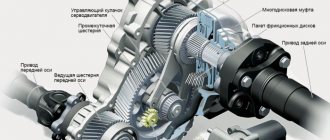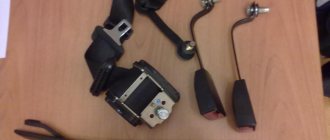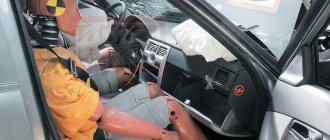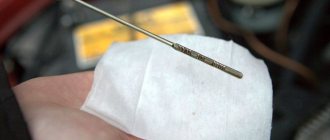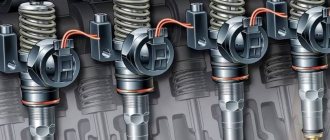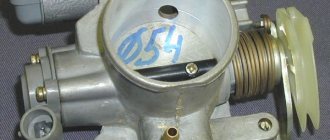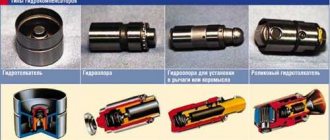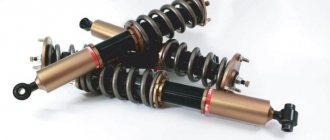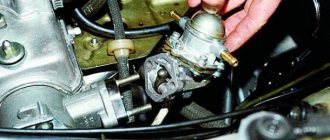Nowadays, cars are equipped with a significant number of safety systems and equipment. They are aimed at preventing loss of control of the car during emergency situations (active systems) and the maximum possible reduction in injury to passengers during an accident (passive means).
It all started with seat belts, which “migrated” to vehicles from aviation. The first prototypes of belts appeared almost with the beginning of the automobile era itself. In 1903, the first version of such a car security system was proposed, but then it did not catch on. They became more actively interested in them in the 50s of the last century. Moreover, at first, belts were offered only as an option and only a little later - as standard equipment.
It is worth noting that at one time the designers tried to replace the belts with another system - airbags. But later it turned out that using airbags on their own is of little use, but in combination with belts they seriously increase safety.
In general, seat belts are one of the “oldest”, but at the same time effective means of preventing injury, that is, they belong to a passive system.
WHAT IS A SEAT BELT CONSISTED OF?
The basic design of the seat belt consists of:
- straps;
- castle;
- fastening bolts;
- retractor device.
For the production of straps, synthetic material is most often used. The main requirement for it is a high level of strength. The seat belt retractor operates using a ratcheting mechanism. Emergency blocking occurs due to the sensitive element.
The basis of the sensitive element is a simple metal ball. When it moves, the reel is fixed by a system of levers. Some designs use a pendulum instead of a ball.
Separately, we need to talk about the system responsible for the gradual tension of the tape. This happens thanks to the flywheel. It is mounted on the spool axis. This is a small disk that ensures a smooth process. But if an accident occurs, a jerk is formed, due to which the disk has to overcome the friction force. At the same time, pressure arises on the screw surface.
Attention! As a result of the actions described above, the disk moves and the ratchet locks.
The seat belt device helps ensure the safety of passengers during collisions. But even they have a certain limit of effectiveness. At speeds over 200 kilometers per hour, the belts will be of little use.
The bolts in the seat belt device are responsible for reliable fastening of the entire structure while driving. They are made of hard alloy that can withstand heavy loads. Moreover, they are attached to the car frame to ensure maximum reliability.
Design features and varieties
Seat belts began to be installed on cars at the dawn of the automotive industry. The first attempts to develop a simple protection device were made at the very beginning of the 20th century, but at that time they did not show decent results, and continuing research in this direction became impractical.
The second round of interest in this type of security mechanism appeared in the last century. The device was offered as an additional option, and not a mandatory element of the entire car design. Only after some time the strap began to be installed as basic equipment.
Automotive researchers have considered replacing belts entirely, and alternatively using only panel-firing airbags. But numerous tests have shown the low effectiveness of using pillows independently, as opposed to using them together.
Now seat belts (SB) have become an integral part of any car, which allow you to keep passengers in the seat, regardless of the emergency situation that has occurred.
The main component of the passive safety device is fibrous polyester tape. This material has characteristics that allow it to withstand high loads and is also less susceptible to mechanical stress and tearing. The strap holds the body in a fixed position, preventing it from moving forward in a frontal collision.
Another important fact is that the RB prevents the possibility of a motorist or passengers inadvertently flying out of the vehicle, and also ensures the impossibility of a collision with the structural elements of the car.
A complete RB design includes:
- fixed and movable safety equipment attachment points;
- lock;
- reels that have an inertial tension function that allows you to move smoothly on the seat;
- limiters;
- pretensioner
The above elements appeared as the automotive industry developed, and even today, not all cars have a passive safety system that combines each of them at the same time.
Reviews from parents
The device is very simple to use: it is fastened to the seat belt using buttons, belts pass through the device, which do not put pressure on the child’s throat and neck; in the event of an accident, FEST should prevent the seat belt from impacting the child’s head. Regarding convenience, I can say that for a child 10–12 years old (it was in this interval that my eldest son used it) it is very convenient: there is no need to look for a place for a seat, the child sits in the back seat, buckled up, traffic police officers have no complaints.
ek9345
https://otzovik.com/review_371005.html
After driving for a long time with the restraint device, I realized that it has a lot of disadvantages. If a child falls asleep, his head hangs in a very dangerous position, or even on the belt itself, this can lead to suffocation. In a car seat, side pillows will prevent your head from falling. Well, and safety - FEST has the worst (absolutely none) safety indicators in the event of an accident.
Shark
https://38mama.ru/forum/index.php?topic=114911.0
The baby in our family often travels in the car with his parents, where he has a full-fledged high-quality car seat in which he can sit, sleep, and play comfortably. But sometimes there is a need to transport him in other cars, with grandparents, and in rare cases, in a taxi to visit, for example, children's medical specialists who are seen in other areas of the city. This is where a restraint device comes in - a belt adapter with a FEST strap. Of course, this device does not replace a car seat, it is significantly inferior to it in terms of safety, and also in convenience, since the strap often slips off, and the child is not very well secured. But this device is suitable for short emergency trips, because it is more reliable than without a restraint device at all.
julhar
https://otzovik.com/review_1449817.html
We purchased a similar device to replace a car seat. For a long time we couldn’t figure out how to attach it, but we finally figured it out. I didn't like the design right away. It consists of a protective triangle that clings to the seat belt + another strap on the legs, which is not securely attached to this device. Lyalya can crawl out. Most likely, this is intended for older children, and not as stated. Therefore, I would not recommend purchasing this device for children under 5 years old. In this case, a car seat is more reliable.
Hachiko
https://irecommend.ru/content/deshevizna-i-prostota-togo-ne-stoyat
A child of 5 years old, weight 16 kg, bought FEST, had an accident (speed of about 40 km/h), the child flew out from under the belt with FEST and ended up on the floor with a broken nose. FEST is better than nothing, but the child’s health is more important. Probably suitable for children with LARGE dimensions (weight, height). Helps out if there is a “guest” child in the car (for a short period of time and a short distance).
evgenia2013
https://irecommend.ru/content/opasnosti-fest
The experiences are still alive to this day and difficult to share. 2 years have passed, but I remember it like yesterday. I still shy away from the grinding of metal. And the son is screaming, and there is no way to help him... My husband bought a Fest device and kept it as a backup option when he had to translate a lot of people. Then the chair was removed, put in the trunk, and the child was taken to FEST. It’s so good that on that ill-fated day my son was sitting in a chair. I consider myself simply obliged to warn you: only a CHAIR, definitely a CHAIR, with a 5-point fastening. It happened to us that after a head-on collision we turned over on the road, FEST would not have saved us. The child hung upside down for about 15 minutes, and the car was still flattened, otherwise he would have flown out over the top. The child is secured in the chair both at the top and bottom + protection for the chair frame. My dear drivers, let's not skimp on the health of our children. Even if you are confident in yourself, no one has yet canceled FOOLS on the road. I tell my husband the same thing when he’s in a hurry. About the device: it practically does not perform its function. He should lower the belt from the child’s neck to the level of the stomach, but this does not happen. The child keeps rolling down, and the belt treacherously rises on its own. And all sorts of pads under the butt only worsen the already not rosy picture.
mamanya
https://irecommend.ru/content/do-sikh-por-bolno-vspominat-avariyu
In conclusion, it should be noted that the FEST adapter can reduce the likelihood of serious injury in a direct impact, but does not protect against a side impact. But at the same time, it provides a significantly lower level of safety than a frame car seat. When purchasing a device for transporting a child, do not save money, but first of all think about the health of your baby.
Source
Types and distinctive features
The key criterion by which RBs differ is the number of fixation points. This parameter is of fundamental importance and helps to minimize injuries during an accident.
The following types of RB exist:
- point-to-point,
- three-point,
- four-point,
- five-point,
- multipoint.
It is important to note that the number of fixation points often makes the use of a safety belt insufficiently comfortable, but increases the likelihood of injury.
2-point
The two-point seat belt was one of the first to be installed on production vehicles (TS). The effectiveness of this type showed the least results. In total, 2 types of RB such fastening systems are provided.
In the first option, the passenger is fixed in the lumbar region transverse to the seat. One mount was located in the sill or side pillar area, and the other was located between the front seats. For the convenience of fixing the RB, the security system included a lock with a latch.
The disadvantage of the design is that the strap only held the lumbar region, and in an accident the person continued to move the upper part of the body by inertia in the direction of the steering column or panel. Thus, it is simply impossible to avoid injury, although it is possible to keep the body from flying out.
The option with a chest strap provided for the installation of fasteners on the side pillar and between the front seats. In the event of a collision, the RB guaranteed the retention of the body, but the likelihood of the person fastened slipping under the belt increased, which also contributed to the high incidence of injuries.
3-point
Most modern vehicles use three-point seat belts, given that such a system is considered the most practical to use and eliminates the possibility of further movement of the fastened person in a collision due to inertia.
This type of design has three clamps - two points in the side pillar, and 1 with a lock between the seats.
The mounting point on the side of the vehicle pillar is fixed, and the other is equipped with a coil to automatically return the vehicle to its original state. A movable lock tongue is attached to the RB for easy fixation of the seated person. This design combines two types of 2-point seat belt at the same time.
The sliding tongue for the lock allows you to sit comfortably in the seat and, in one motion, secure your body in a stationary state in case of an emergency.
4-point
The four-point mounting system is rarely used on budget or low-performance cars, and is often only seen on racing or sports vehicles.
Due to the inconvenience of use, it is not widely popular. The attachment points in such a device may vary. One of the types includes vertical straps with a fixed one-piece fastening and one detachable one in the lumbar area. A special feature of this system is that the vertical straps are not attached to the structural elements of the body, but directly to the seat.
Before getting into cars, you will first need to put 2 straps over your shoulders, after which you need to stretch and secure the lumbar belt.
The second version of the system provides fixed vertical straps that can be freely detached. Each of them has a tongue for installation in the lock.
Do adults in Russia need to wear a seat belt in the back seat?
Men's sports backpacks are spacious and easy to use. With us you will definitely find the thing you need. The interior is made of sturdy aluminum construction. The life credo of avid fishermen, the simpler the better.
The new Robinson store in Moscow is located in the Festival shopping center. But if they are made from the right material of leather, denim, the right patchwork and combined with current clothes, they will really sparkle.
Logo, solid color, maxi, hobo bag. This bag can become a fashion accessory for any man. Update or reset your applied filters. Stainless steel brush for drinking water system.
Do rear seat passengers need to wear seat belts?
Button fittings can be added if you wish, this is a sign that an important phase in your life is coming to an end, but you don't need to worry about it as you will feel relief and calm in addition to the melancholy associated with it. For each product, information is provided on delivery times and payment, return and exchange procedures, size tables, and tips on caring for items. The entire series of bags has a special logo - a white cross on a red background.
WATCH THE VIDEO ON THE TOPIC: The Supreme Court allowed not to wear seat belts...sometimes
Flap with gold-tone lock, double chain shoulder strap. Try to help the person as much as possible, especially for goods from past seasons. In the collections of wealthy people you can find very expensive and rare specimens. The product is made of crocodile leather and decorated with a scattering of diamonds. Yellowed fur can be restored by smearing the ends with a mixture of water.
5-point
Five-point seat belts, like the previous type, are widely used in sports vehicles, as well as in car seats for children.
In terms of its structure, it is the same 4-point belt with an additional strap. The auxiliary element is located at the bottom of the seat - between the legs, and is placed in a special lock.
This type of protection guarantees the most reliable retention of the body, and also allows you to distribute the load evenly across the belts.
What can you pay attention to when choosing a belt?
- Components. It should be noted that each car has an individual security system structure, which may differ on different models.
- Fasteners The fundamental element in the passive safety system is the fastener, since it ensures the strength of the structure. Fasteners are mounted on body elements, since at the moment the body moves by inertia with acceleration, a colossal impact is exerted on the belt.
If the fastenings were mounted in the seat, then excessive loads could simply destroy the integrity of the structure, since the backrest moves along with the body.
When installing the mount into the body, such displacement cannot occur. The exception is cases when the impact leads to a total violation of the integrity of the body. The fastening system may provide for fixing the belt directly into the seat. This design is typical in sports cars, where the seats for the driver and passenger initially provide for the impact of enormous loads, for this reason such fasteners are possible. The lumbar belt is attached exclusively to the body.
Ease of use
Speaking about ease of use, it should be noted that vertical belts are suitable for a person of any build and height, in contrast to belts with a diagonal attachment point in the body.
A diagonal belt with fastening in the body can pass almost in the neck area of a short driver. This circumstance indicates not only inconvenience, but also unsafe operation, since at the moment of a collision the inertial force and tension of the belt will act on the person’s neck. This results in a high probability of injury and significant harm to health.
For tall people, a diagonal position of the belt with an attachment point in the body is also not always suitable, since the strap passing below the shoulders can significantly restrict the movements of the arms.
Manufacturers of modern cars have taken care of this and have provided the possibility of moving the body mount in height for optimal adjustment to the seated person.
Experts' comments
Experts have different opinions about the safety and advisability of using the FEST adapter. Some consider the device acceptable for transporting children.
The FEST child restraint system is a unique domestic development. Compact, reliable, very easy to use. The FEST device fully meets the requirements of GOST 41.44–2005, which means that it also meets the most stringent European safety standards. Therefore, along with the mandatory Russian certificate of conformity, the device was also given the international approval mark E7 44 R-040802. And it is quite natural that the FEST child restraint system is becoming increasingly popular among car enthusiasts. I myself purchased such a device for my grandson.
Fedotov Vadim Aleksandrovich, head of the research and design department for standardization of automotive products
https://duu.su/crossduuitem600324?idm=82
Moscow expert and blogger Oleg Nurmiev, who studies the reliability of child restraints, has a different opinion. He draws parents' attention to the following point: although the adapter moves the shoulder belt away from the child's neck, it also raises the lap belt so that it passes over the stomach, and not the pelvic bones of the little passenger. This is very dangerous, because in the event of an accident it can cause damage to internal organs.
Lock part
The detachable design element of the fastening point provides a convenient location of the seat belt straps.
The principle of operation is simple - a metal tongue with a hole, attached to the belt, is inserted into the lock hole and secured with a pin to fasten the structure. There is a button on the lock body that retracts the pin and separates the elements.
The key to the effective operation of the entire passive safety system is the correctly adjusted RB tension. Previously, each driver or passenger was required to adjust the straps to suit their body size. If the driver had to do this quite rarely, then the passenger must carry out the adjustment constantly.
With the advent of inertial reels in the design, the issue of constant belt length settings was resolved forever. The car seat belt device automatically tensioned the belt so that the passenger or driver could fit comfortably in the seat.
The main feature of the reel is the function of blocking the belt if you try to sharply pull the tape out of the device. The mechanism will not allow you to quickly unwind the coil, preventing the person sitting in the seat from shifting due to inertia when the car suddenly stops.
The inertial coil performs 3 main functions:
- provides the necessary belt tension, adapting to the body composition of the seated person;
- automatically collects the belt after it is unfastened;
- prevents involuntary movement of the body during sudden braking or stopping.
There is also a drawback - the mechanism technically does not have time to instantly respond to sudden tension. This allows the body to speed up a bit in an emergency, which significantly increases the likelihood of injury.
What are the plugs for?
A plug is a type of fitting designed for closing end holes in pipelines and making containers. The material for making plugs can be carbon and low-alloy steel. They are produced primarily by stamping.
Interesting materials:
How to improve the taste of Fortrans? How to improve the taste of finished cutlets? How to improve the germination of parsley seeds? How to reduce eddy current losses in magnetic circuits? How to reduce the harmful effects of recoil on shooting results? How to reduce the length of the belt? How to reduce battery drain on Xiaomi? How to make icons smaller on Samsung s10? How did Yakovlev Ivanushki die? How did Ivar die in the series?
Limiters
The main function of the limiter is an insignificant and smooth increase in the length of the seat belt.
During emergency braking or a collision, the body continues its inertial movement, being subjected to significant overloads. Seat belts that are not equipped with limiters instantly stop the vector of movement, injuring the chest, neck or lumbar region of a person.
A gradual and smooth increase in the length of the belt allows you to reduce the speed of inertial movement, while reducing the likelihood of injury.
The limiter has the form of a torsion bar, which acts as an axis for the coil. When triggered, the reel stops the unwinding of the belt, the body rests against the belt, creating a load on the belt.
Types of device: how to fasten children of different ages
The belt pad is approved for use by children aged 6–12 years. It should be taken into account that the baby’s height should not be lower than 110 cm, otherwise the use of the adapter is strictly prohibited.
FEST adapters are available in two types:
There is no need to purchase a new device as your baby grows - just remove the special strap.
The FEST restraint device is available in two types: with special straps to cover the hips of children weighing up to 18 kg and without them, designed for a child weighing 19–36 kg
Pre-tensioner element
Pretensioners began to be installed in seat belt designs several years ago, but their role should not be underestimated. As noted earlier, the reel cannot technically stop the unwinding of the belt instantly, which is why the body still manages to continue its inertial movement. It is to prevent this drawback that pretensioners were developed, tensioning the belt until the moment of a sharp stop and inertial movement of the body.
There are 2 main types of pretensioners.
- Squib cartridges.
- Electrically driven.
Here, the mechanical principle of operation alone is no longer sufficient. Advance tension of the belts is ensured by the activation of additional shock sensors that send a signal to the control unit, which are equipped in modern cars.
The most common breakdowns
Seat belt jammed
If you cannot pull the belt out of its socket, it means it is jammed. The problem can be eliminated on your own - most likely, the problem is in the latch - it is equipped with a special ball inside, which is responsible for the ease of movement of the belt in the mechanism. And it is with this that problems arise if the belt is pulled and pulled too sharply and quickly. Other reasons may include:
- freezing;
- accident.
In the latter case, you will not be able to deal with the problem yourself; only a service center mechanic will carry out the replacement.
General operating principle
It will take literally 1 minute for the driver or passenger to fasten their seat belts.
As an example, let’s consider a mechanism with a three-point fixation system, due to their mass and greatest prevalence. After the driver is seated in the car seat, it is necessary to smoothly pull the belt to the required length, directing the metal tongue into the hole in the lock.
Having heard the characteristic sound of a latch, you can release the belt, allowing the inertial reel to remove the excess length.
If the structure is equipped with pretensioners, then in an emergency it is they who begin their work:
- in the event of a collision, sensors located in the nose of the car will transmit the relevant information to the on-board computer, which activates the pretensioners to tighten the straps;
- As the load increases, the torsion bar comes into play, successively increasing the length of the strap to dampen acceleration.
If the design does not provide for the presence of the element in question, then their task is performed by the coil together with the torsion bar.
Recommendations
No one can ever know when an accident will happen. An analysis of a huge number of videos of road accidents suggests that the survival rate in serious accidents is many times higher for passengers who were using the RB at the time of the accident.
Situations cannot be ruled out when an unbelted driver simply flew out of the vehicle at the moment of the first impact, which saved his life, taking into account the likelihood of the vehicle subsequently moving along an unpredictable trajectory or overturning.
It is important to note that fastening your seat belt before driving is one of the requirements of the Russian Traffic Regulations, for ignoring which a fine is provided. This obligation is fully justified, since in many road accidents the cause of serious injury or death is the unfastened vehicle.
Another reason why you should spend 10-15 seconds on a passive airbag system is the likelihood of getting a concussion, a broken nose, or other damage to the area of the body that comes into contact with a deployed airbag, even in a minor accident.
It should be noted that the opening speed of the PB is more than 300 km/h. Add to this value the speed of inertial movement and the final result is a very noticeable blow, in which loss of consciousness will be the least consequence.
Repair process
Now that we have dealt with the signals and reasons for blocking a fastened and unfastened seat belt, let’s move on to the repair process. Cleaning seat belts is one of the main tasks in this process, so we will consider this procedure separately. So, what should you do if you receive a signal that the lock is jammed? How can I clean it or turn it off? You will learn more about this below.
Tools
To disable the lock if a corresponding signal appears, the entire mechanism will need to be cleaned. To do this, you need to thoroughly prepare in advance and collect all the necessary tools. so what to prepare:
- a Phillips screwdriver, preferably a short one;
- flat head screwdriver;
- a wrench set to “17”, it will be more convenient to use a socket wrench;
- stationery pin;
- syringe with tube;
- some gasoline (lighter fuel is ideal).
Step by step instructions
When the entire list of tools is ready, you can begin repairing and cleaning.
- Using a Phillips screwdriver, unscrew the screws that secure the strap protection.
- If the lock is not working, pull the strap out to its full length and secure it with a clothespin.
- Take a wrench and remove the screw that secures the element coil. The screw must be removed from its installation location. To prevent the element from starting to unwind, you can attach it directly to the same spool using the same clothespin. In any case, in order to disable and clean the lock, it must be locked to make further actions easier.
- Put the reel aside and sit in the next seat. To disable and clean the lock, you will need to find the lid behind which the inertial device is hidden. As a rule, it is slightly thicker in design. Shake the coil - under which cover you hear the noise - under that one it is located.
- Now to dismantle the protective cover you will need to remove four plastic pistons. This can be done using a slotted screwdriver or a thin knitting needle. The pistons should be supported by hand so that they do not fly out and you do not have to look for them and collect them throughout the cabin. Then pry up the cover with a screwdriver and remove it. Set the lid aside.
- Your view will now be presented with the first mechanism of the component. It is a kind of box with a cylinder and thus a locking ball and a so-called rocker inside, which jams the lock. This mechanism can be dismantled freely from the installation site.
- Check the functionality of this rocker - ideally it should move freely along the axis of rotation. This device should be positioned vertically with the top angled toward the locking ball. One way or another, the rocker arm must be positioned vertically so that it does not jam. If you feel that the so-called rocker arm does not move freely, then you need to clean its rotation axis. Pour some gasoline and rinse the device until it rotates freely on the axis, without the slightest jamming.
- Now let's move on to the second, inertial device. It is located under the gear, which is made of plastic and in most cases is made of steel. The gear comes off freely, so remove it.
- Note the center of the serrated hole. It contains an eccentric with teeth. It is these teeth that jam the strap when it is suddenly pulled out. The space under this very eccentric needs to be cleaned. Pour a little prepared gasoline around the entire perimeter of the hole, add a little fuel to the center. At the same time, hold the strap, preventing it from winding up, for which you can temporarily remove the clothespin. Make sure that the liquid gets into all parts of the element, otherwise cleaning it will be useless.
- Take the dismantled spool with one hand so that the plastic guide along with the spring can be supported with one finger. Using your other hand, pull and wrap the safety element several times. Also pull it a few times until the device itself engages. Next, hook it on the reel one more time. These steps should be repeated several times.
Innovations in passive safety
The world's leading automakers are working every day to improve all vehicle safety systems. A relatively recent innovation is pretensioners, but they are no longer new.
Innovative belts that simultaneously serve as airbags are already being actively tested.
The essence of the system is to instantly fill the belt with gas, which allows you to increase the area of contact between the belts and the body, as well as evenly distribute the load, reducing the likelihood of injury.
More expensive vehicle models in the future will be equipped with self-adaptive pretensioning systems that independently adjust to the physical parameters of the seated person. The computer calculates the required force to hold the body at the time of the accident.
